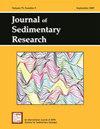硅质海岸环境中现代砾石沉积的微生物席定植
IF 2.1
4区 地球科学
Q1 GEOLOGY
引用次数: 0
摘要
微生物垫是定居在表层沉积物中的微生物的层状群落,改变了它们的物理和化学特性。巴塔哥尼亚北部海岸线(阿根廷)包括更新世和全新世期间通过高能流体动力学过程积累的砾石沉积物(称为rodados Patagónicos)。在该地区,残留潮道(Paso-Seco;40°38′27〃S,62°12′55〃W)中的表层沉积物被微生物垫广泛定殖,似乎过度生长在裸露的砾石沉积物中。到目前为止,还没有报道这种基质适合开发微生物垫。本文的目的是:1)描述微生物阻挡、捕获和结合沉积颗粒的机制,以及使表海底微生物垫能够在砾石基质上发育的生物稳定,2)将微生物垫的生长与各种流体动力学条件联系起来,3)描述由此产生的微生物诱导沉积结构(MISS)。我们的假设是,间歇性海水泛滥、停滞和排水与随后的陆上暴露和干燥的交替是砾石垫发育的控制因素。一旦停滞,泥浆大小的沉积物颗粒就会从悬浮液中沉淀下来。同时,使用细粒物质作为基质,可以在底部建立初始生物膜。随后引入的颗粒被阻挡、捕获并结合到正在形成的生物膜基质中。在澳大利亚冬季,相对较高的叶绿素a和有机物值表明该季节微生物垫的生长增加。随着连贯性的增强,发育中的微生物垫可能会侵占单个鹅卵石,最终吞噬它们。最终,一个成熟的表海底微生物垫平整了沉积表面。洪水期间的流体动力学改造会产生MISS,如垫子碎片和翻转的垫子。本文章由计算机程序翻译,如有差异,请以英文原文为准。
Microbial-mat colonization of modern gravel deposits in a siliciclastic coastal setting
Microbial mats are layered consortia of microorganisms colonizing surface sediments that alter their physical and chemical characteristics. The northern Patagonia coastline (Argentina) includes gravel deposits (termed rodados Patagónicos) accumulated during the Pleistocene and Holocene by high-energy hydrodynamic processes. In this area, surface sediments in a relict tidal channel (Paso Seco; 40° 38′ 27″ S, 62° 12′ 55″ W) are extensively colonized by microbial mats, appearing to overgrow exposed gravel deposits. To date, such substrates have not been reported as suitable for the development of microbial mats. The objectives of this paper are: 1) to describe the mechanisms of microbial baffling, trapping, and binding of sedimentary particles, and biostabilization that enable epibenthic microbial mats to develop on gravel substrates, 2) to relate microbial mat growth to a variety of hydrodynamic conditions, and 3) to describe resulting microbially induced sedimentary structures (MISS). Our hypothesis is that the alternation of episodic seawater flooding, stagnation, and draining with subsequent subaerial exposure and desiccation are the controlling factors for mat development on gravel. Once stagnant, mud-size sediment particles settle from suspension. At the same time, an initial biofilm may become established on the bottom, using the fine-grained material as substrate. Subsequently introduced particles are baffled, trapped, and bound into the developing biofilm matrix. During the Austral winter comparatively higher values for chlorophyll a and organic matter point towards increased growth of the microbial mat during this season. With increasing coherence, the developing microbial mat may encroach onto individual pebbles, ultimately engulfing them. Eventually, a mature, epibenthic microbial mat levels the sedimentary surface. Hydrodynamic reworking during flooding produces MISS such as mat chips and flipped-over mats.
求助全文
通过发布文献求助,成功后即可免费获取论文全文。
去求助
来源期刊
CiteScore
3.80
自引率
5.00%
发文量
50
审稿时长
3 months
期刊介绍:
The journal is broad and international in scope and welcomes contributions that further the fundamental understanding of sedimentary processes, the origin of sedimentary deposits, the workings of sedimentary systems, and the records of earth history contained within sedimentary rocks.

 求助内容:
求助内容: 应助结果提醒方式:
应助结果提醒方式:


